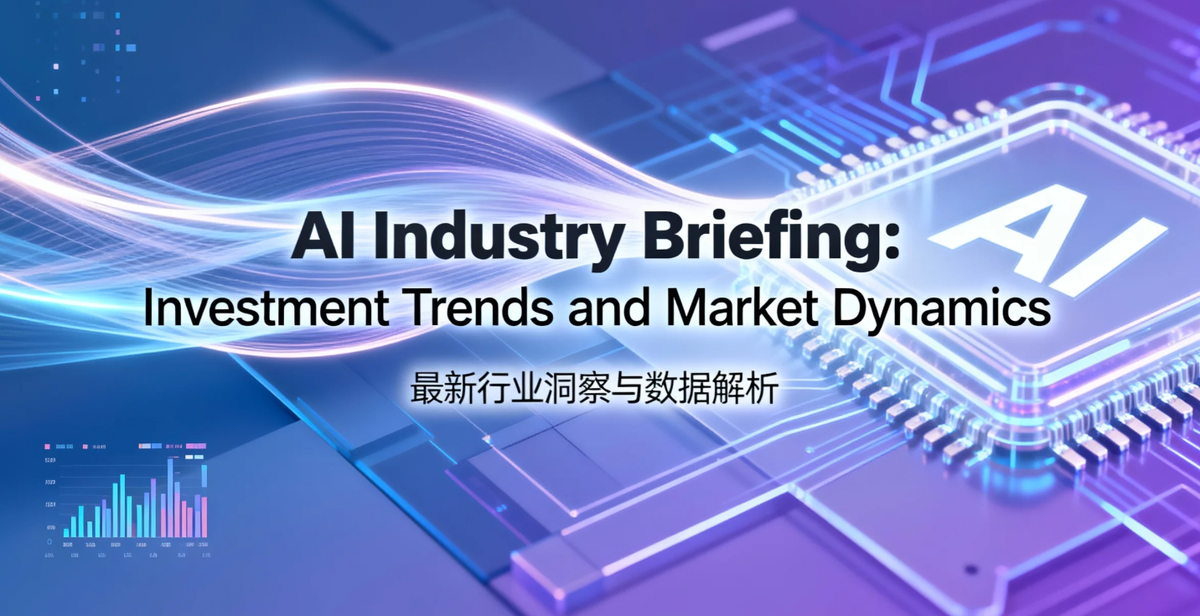AI Industry Briefing: Investment Trends and Market Dynamics

Thursday, October 30, 2025
Policy Signal: Federal Reserve Views AI Investment Positively
Federal Reserve Chair Jerome Powell addressed AI industry investments during a press conference this week. According to multiple financial media outlets, Powell drew a distinction between the current artificial intelligence investment wave and the late-1990s internet bubble, arguing that fundamental differences exist between the two.
Powell noted that AI-related investments are already making substantive contributions to economic growth, unlike many internet-bubble-era companies that lacked viable business foundations. The market interpreted this statement as a policy signal supporting the technology sector's large-scale AI investments.
Sources: CNBC, Bloomberg, and other mainstream financial media coverage of Federal Reserve press conference
Big Tech Earnings Season: AI Spending Takes Center Stage
Meta, Alphabet, and Microsoft released third-quarter earnings on Wednesday. According to documents filed with the U.S. Securities and Exchange Commission (SEC) and earnings call transcripts, all three companies emphasized the importance of AI infrastructure investments in their reports.
Meta Earnings Highlights
Meta raised its 2025 capital expenditure guidance in the earnings report. According to the company's Form 10-Q quarterly report filed with the SEC, the new capital expenditure guidance range increased from previous estimates. Following the earnings release, Meta's stock price adjusted, primarily due to investor concerns about return timelines for large-scale capital spending.
CEO Mark Zuckerberg stated during the analyst call that AI investments are driving user engagement improvements and creating opportunities for new product lines like Meta smart glasses. The company also disclosed a substantial tax expense in the report that impacted quarterly net income.
For specific financial figures, please refer to Meta's official investor relations website (investor.fb.com) or the Form 10-Q document in the SEC EDGAR database.
Overall Trends
The three tech giants' sustained investments in data centers, AI chips, and related infrastructure have become a significant component of U.S. economic activity this year. These investments not only create direct employment but also stimulate related industries including semiconductor manufacturing, data center construction, and energy supply.
Sources: Company SEC public filings, official earnings calls, mainstream financial media reports
Nvidia GTC Conference: Open-Source Strategy and Market Performance
Nvidia held its annual GTC technology conference in Washington, DC this week. According to the company's official press releases, CEO Jensen Huang announced multiple technology release plans in his keynote, including AI models and tools for the open-source community.
Open-Source Technology Releases
Nvidia announced it will contribute multiple AI technologies to open-source platforms like Hugging Face, covering reasoning models, physical AI, robotics, and biomedical AI. The company stated in press releases that these open-source projects aim to lower AI development barriers and advance industry-wide technological progress.
As a major contributor to Hugging Face, Nvidia has already shared numerous open models and datasets. Industry observers interpret this open-source strategy as a strategic move to consolidate its central position in the AI ecosystem.
Market Performance
During and after the conference, Nvidia stock performed strongly, with market capitalization ranking among the world's top technology companies. Huang expressed confidence in AI market long-term development during his speech, arguing that current investment enthusiasm is supported by solid demand fundamentals.
For specific market cap and stock price data, consult real-time financial data platforms.
Sources: Nvidia official press releases (nvidianews.nvidia.com), mainstream technology media reports
Strategic Partnership: Microsoft-OpenAI Relationship Evolution
According to multiple technology media reports, Microsoft and OpenAI recently announced a deepening of their collaborative relationship. Reports indicate the parties are strengthening their strategic alliance in computing support, technology integration, and commercial cooperation.
Microsoft has deeply integrated OpenAI technology into Azure cloud services, Office product lines, and GitHub development tools. This close partnership reflects how large technology companies are securing technical leadership through strategic investments and partnerships in the AI race.
As OpenAI is a private company, official disclosure of specific agreement details, investment amounts, and ownership stakes is limited. The above information primarily derives from media reports; specific terms are subject to official announcements by both parties.
Sources: Wall Street Journal, Financial Times, Bloomberg, and other mainstream media reports
International Expansion: Google's AI Strategy in India
According to Google's official blog, the company announced plans in mid-October to build AI infrastructure in India. The project, located in Andhra Pradesh, India, is planned for phased implementation over several years, integrating AI computing facilities, data centers, and network infrastructure.
This investment plan aligns with the Indian government's "Viksit Bharat 2047" (Developed India 2047) development vision. India possesses vast technology talent reserves and a rapidly growing digital economy, viewed by global technology companies as an important strategic market.
From a global competition perspective, major technology companies are building more diversified technology and talent ecosystems through international expansion.
Specific investment amounts and timelines are subject to official Google announcements.
Sources: Google official blog, mainstream Indian media reports
Corporate Restructuring: Workforce Adjustments in Tech
Amazon Organizational Optimization
According to multiple media reports, Amazon recently conducted organizational restructuring involving workforce optimization in corporate functions. This adjustment is interpreted as reflecting the company's strategic shift from traditional business toward AI-driven models.
Reports indicate layoffs primarily concentrate in traditional business units, while AI, machine learning, and cloud computing positions continue hiring. This human resource allocation change reflects broader transformation trends across the technology industry.
YouTube Reorganization Plans
YouTube is reportedly conducting similar organizational restructuring. CEO Neal Mohan indicated in internal communications that the reorganization aims to better capitalize on market opportunities created by AI technology.
Specific layoff scale and percentages are subject to official company statements.
Sources: Wall Street Journal, Bloomberg, Reuters, and other mainstream media reports
Technical Progress: IBM Quantum Computing Research
IBM Research announced new progress in quantum computing this week. According to company statements, the research team achieved performance improvements in quantum error correction technology, which has important implications for improving quantum system stability and practicality.
Quantum computing is viewed as a key supporting technology for AI development. More powerful and stable quantum computing capabilities promise to provide new computing paradigms for training large-scale AI models and solving complex optimization problems.
Specific technical parameters and performance metrics are subject to IBM Research official technical documentation.
Sources: IBM Research official statements
Product Developments: Oracle Enterprise AI Solutions
Oracle released new AI capabilities at its Oracle AI World conference held in Las Vegas in mid-October. According to company press releases, new features embedded in Oracle Fusion cloud applications aim to help enterprise customers achieve intelligence in core business areas including finance, human resources, and supply chain.
This signals that enterprise software vendors are transforming AI capabilities from peripheral tools into core business system components, marking enterprise AI applications entering a deep integration phase.
Sources: Oracle official press releases
Market Research: Generative AI Growth Expectations
Market research firms hold optimistic views on generative AI market prospects. Multiple research institutions predict in recent reports that this market could experience rapid growth over the next decade, with primary drivers including continued advances in deep learning, natural language processing, computer vision, and ongoing cloud computing infrastructure improvements.
Regionally, North America maintains leadership through strong research capabilities and an active innovation ecosystem, Asia-Pacific grows rapidly driven by policy support and technology center construction, while Europe develops distinctive characteristics in regulatory frameworks and industrial applications.
Market forecast data comes from third-party research institutions; actual development will be influenced by multiple factors including technology, policy, and business models.
Sources: Mainstream market research institution reports
Security and Governance: Regulatory Focus on AI Applications
As AI technology spreads widely, government and corporate attention to AI security and ethics continues increasing.
Cybersecurity vendors like Palo Alto Networks have reportedly launched security solutions targeting AI applications. India's information technology departments indicate they are developing regulatory frameworks for AI-generated content (such as deepfakes).
These initiatives reflect that while promoting AI innovation, ensuring technology safety and controllability while protecting user rights has become a challenge facing both policymakers and industry participants.
Sources: Corporate official statements, government agency public information, mainstream media reports
Editorial Note
Information Source Standards for This Briefing:
- Financial Data: Prioritizes official documents filed by companies with regulators (e.g., SEC)
- Company Statements: Based on official press releases, investor relations materials, official blogs
- Cross-Verification: Key information confirmed by at least two independent mainstream sources
- Attribution Principle: All important information labeled with source type
- Prudent Expression: Uses conditional language for information that cannot be fully verified, or directs readers to official sources
Specific Data Query Recommendations:
- Financial data: Company investor relations websites or SEC EDGAR database
- Market cap/stock prices: Bloomberg, Yahoo Finance, and other financial data platforms
- Product details: Company official product pages and technical documentation
Disclaimer: This briefing is compiled based on publicly available information. Specific data and details may change due to information updates, regulatory disclosure timing differences, and other factors. Please refer to official primary sources for important decisions.



